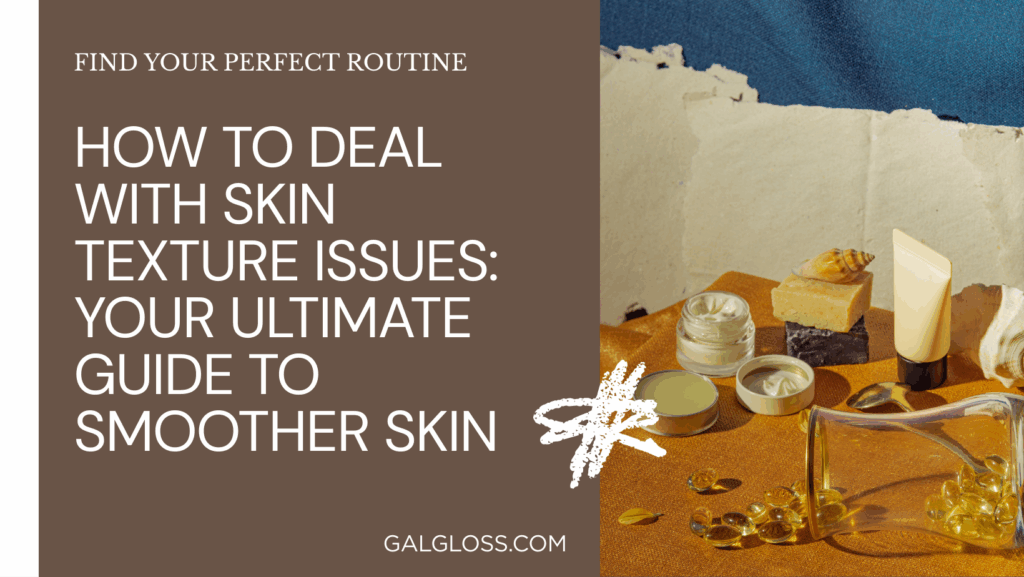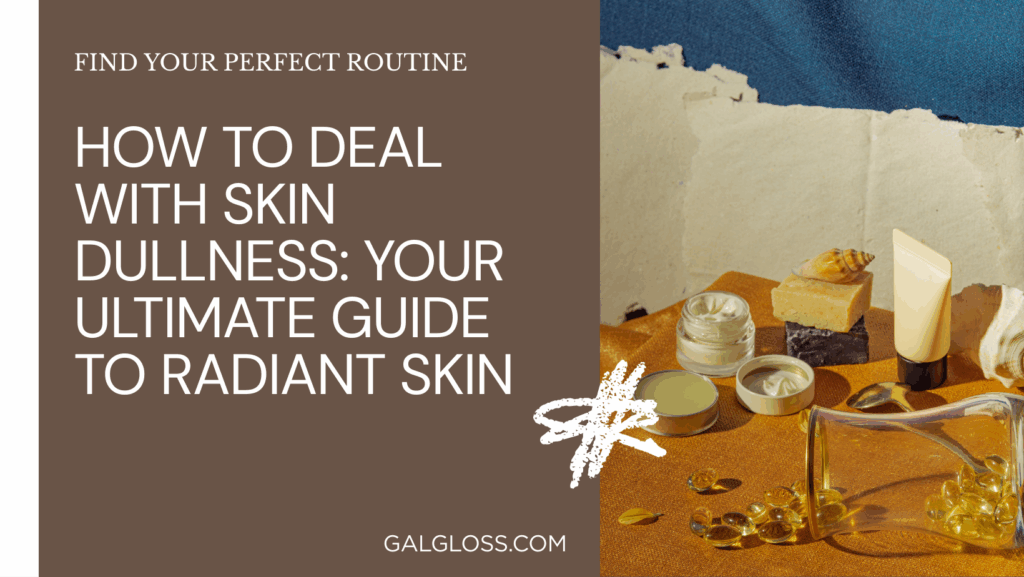Ever caught yourself zooming in on selfies, frustrated by bumps, scars, or uneven patches? You’re not alone. Skin texture issues are like uninvited guests at a party – annoying and hard to get rid of. But don’t worry, we’ve got your back!
In this guide, we’ll dive deep into the world of skin texture problems. We’ll explore what causes them, how to tackle them head-on, and share some pro tips to keep your skin smooth as silk. Ready to embark on your journey to flawless skin? Let’s get started!
What Are Skin Texture Issues, Anyway?

Think of your skin as a canvas. In a perfect world, it’d be smooth and even, like a freshly primed surface ready for painting. But in reality? It’s often more like a bumpy road with a few potholes along the way.
Skin texture issues can show up as:
- Rough patches that feel like sandpaper
- Tiny bumps that just won’t budge
- Large pores that seem to stare back at you in the mirror
- Acne scars that stick around long after the zits have gone
- Fine lines and wrinkles that sneak up when you’re not looking
Sound familiar? You’re in good company. These pesky problems are more common than you might think.
Why Should You Care About Skin Texture?
Now, you might be wondering, “Is smooth skin really that big a deal?” Well, let me ask you this: Have you ever skipped a selfie because your skin looked “off”? Or felt a twinge of envy scrolling through Instagram, seeing flawless faces everywhere?
Dealing with skin texture isn’t just about vanity. It’s about feeling confident in your own skin (pun intended). When your skin looks good, you feel good. It’s that simple.
Plus, addressing skin texture issues often goes hand in hand with improving your overall skin health. It’s a win-win situation!
Understanding Skin Texture: The Basics
Before we dive into solutions, let’s get to know our skin a little better. What exactly determines skin texture?
- Collagen and Elastin: These are the building blocks of smooth skin. Think of them as your skin’s scaffolding, keeping everything firm and bouncy.
- Cell Turnover: Your skin is constantly shedding old cells and making new ones. When this process slows down, you might notice roughness or dullness.
- Hydration: Well-hydrated skin is plump and smooth. Dehydrated skin? Not so much.
- Oil Production: Too much oil can lead to clogged pores and acne, while too little can cause dryness and flakiness.
- External Factors: Sun exposure, pollution, and even your diet can all impact your skin’s texture.
Common Skin Texture Issues: The Usual Suspects
Let’s break down the most common texture troubles:
- Acne Scars: These are the stubborn reminders of pimples past. They can appear as indentations or raised spots.
- Large Pores: While you can’t actually shrink pores, you can minimize their appearance.
- Rough Patches: These can feel like sandpaper to the touch and often show up on cheeks or foreheads.
- Uneven Skin Tone: This includes dark spots, redness, or areas of hyperpigmentation.
- Fine Lines and Wrinkles: These are often the first signs of aging and can make skin look less smooth.
What’s Causing Your Skin Texture Problems?
Identifying the culprit is half the battle. Here are some common causes:
- Hormonal Changes: Puberty, pregnancy, menopause – all can wreak havoc on your skin.
- Sun Damage: Those UV rays aren’t just causing wrinkles; they’re messing with your skin texture too.
- Poor Skincare Routine: Skipping cleansing or over-exfoliating can both lead to texture issues.
- Dehydration: Not drinking enough water? Your skin might be the first to show it.
- Diet and Lifestyle: What you eat and how you live can show up on your face.
At-Home Solutions: DIY Skin Smoothing
Ready to take matters into your own hands? Here are some at-home strategies to tackle texture issues:
1. Establish a Proper Skincare Routine
A consistent routine is key. Here’s a basic structure:
- Cleanse: Twice daily, use a gentle cleanser suited to your skin type.
- Exfoliate: 1-2 times a week, use a chemical or physical exfoliant to slough off dead skin cells.
- Treat: Apply serums or treatments targeting your specific concerns.
- Moisturize: Lock in hydration with a suitable moisturizer.
- Protect: Always finish with SPF during the day.
2. Best Ingredients for Improving Skin Texture
Look out for these powerhouse ingredients:
- Retinoids: The gold standard for improving skin texture. They boost cell turnover and stimulate collagen production.
- Alpha-Hydroxy Acids (AHAs): These exfoliating acids help remove dead skin cells and promote a smoother texture.
- Vitamin C: A potent antioxidant that brightens skin and boosts collagen production.
- Niacinamide: This form of vitamin B3 helps minimize pores and even out skin tone.
3. DIY Face Masks and Treatments
Try these homemade remedies:
- Honey and Oatmeal Mask: Mix equal parts honey and ground oatmeal for a soothing, exfoliating mask.
- Yogurt and Turmeric Mask: Combine 2 tablespoons of plain yogurt with a pinch of turmeric for brightening and smoothing.
- Avocado and Olive Oil Mask: Mash half an avocado with a teaspoon of olive oil for deep hydration.
4. Lifestyle Changes for Better Skin Texture
Don’t underestimate the power of lifestyle tweaks:
- Stay Hydrated: Aim for at least 8 glasses of water a day.
- Eat a Balanced Diet: Load up on fruits, veggies, and foods rich in omega-3 fatty acids.
- Get Enough Sleep: Aim for 7-9 hours per night. Your skin repairs itself while you snooze!
- Manage Stress: Try meditation, yoga, or any activity that helps you unwind.
Professional Treatments: When to Call in the Experts
Sometimes, at-home remedies aren’t enough. Here are some professional treatments to consider:
- Chemical Peels: These use stronger acids to remove the top layer of skin, revealing smoother skin underneath.
- Microdermabrasion: This treatment uses tiny crystals to gently sand away the outer layer of skin.
- Laser Resurfacing: Various types of lasers can target different skin concerns, from acne scars to fine lines.
- Microneedling: Tiny needles create micro-injuries in the skin, stimulating collagen production.
- Dermal Fillers: These can help smooth out deep wrinkles and acne scars.
Remember, always consult with a certified dermatologist or aesthetician before trying any professional treatments.
Prevention Tips: Keeping Your Skin Smooth in the Long Run
An ounce of prevention is worth a pound of cure, right? Here’s how to maintain that smooth texture:
- Sun Protection: This is non-negotiable. Use a broad-spectrum SPF 30 or higher daily.
- Consistent Skincare: Stick to your routine, even when you’re tired.
- Regular Professional Treatments: Consider getting facials or light peels every few months.
- Don’t Smoke: Smoking is terrible for your skin (and overall health).
- Be Gentle: Avoid harsh scrubs or hot water, which can damage your skin barrier.
When to See a Dermatologist
While many texture issues can be addressed at home, some situations call for professional help. Consider seeing a dermatologist if:
- Your skin texture changes suddenly or dramatically
- You have persistent acne that won’t clear up with over-the-counter treatments
- You notice any suspicious moles or skin changes
- Your skin texture issues are affecting your self-esteem or quality of life
During your visit, be prepared to discuss your skincare routine, diet, and any medications you’re taking. Your dermatologist might perform a skin analysis or even a biopsy to get to the root of the problem.
Conclusion: Your Journey to Smoother Skin Starts Now
Dealing with skin texture issues can feel like an uphill battle, but remember – smooth, glowing skin is within reach. It’s all about understanding your skin, being consistent with your care, and knowing when to seek professional help.
Here’s a quick recap of our smooth skin strategy:
- Understand your skin and its specific needs
- Establish a consistent skincare routine
- Use targeted ingredients like retinoids and AHAs
- Don’t underestimate the power of lifestyle changes
- Consider professional treatments for stubborn issues
- Always, always protect your skin from the sun
Remember, everyone’s skin is different. What works for your best friend might not work for you. Be patient, be consistent, and don’t be afraid to experiment (safely) to find what works best for your unique skin.
Your skin is with you for life, so treat it with love and care. Here’s to smoother days ahead!
FAQs
- How long does it take to see improvements in skin texture? It depends on the treatment and your skin, but generally, allow 4-6 weeks to see noticeable changes.
- Can skin texture issues be completely eliminated? While perfect skin is a myth, most texture issues can be significantly improved with proper care and treatment.
- Are there any natural remedies for skin texture problems? Yes! Ingredients like honey, oatmeal, and yogurt can help improve skin texture naturally.
- How often should I exfoliate to improve skin texture? Most people benefit from exfoliating 1-2 times a week. Over-exfoliating can damage your skin, so start slow!
- Can makeup help conceal skin texture issues? While makeup can help, it’s best to focus on improving your skin’s health. Use primers and lightweight, hydrating foundations for the best results.
Ready to start your smooth skin journey? Remember, consistency is key. Your future self (and your selfies) will thank you!





